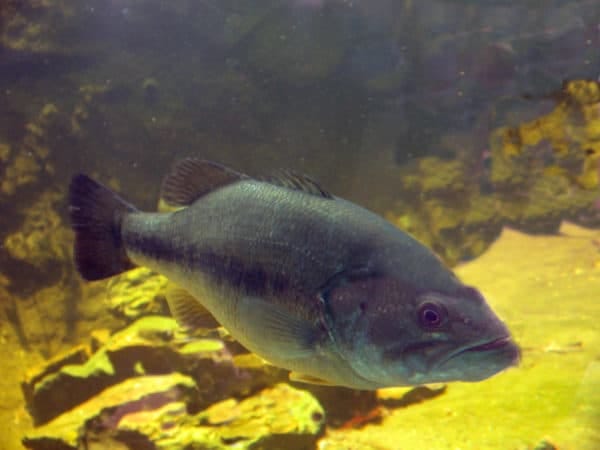by John E. Phillips
As the bone-colored Zara Spook did the Texas Two Step across the water about 6 to 8 feet from the riprap below the dam, leaving a V-shaped trail on the surface, I watched for a bass to blow up.

Riprap provides a great place for bass to hold and ambush baitfish.
The Spook, named for a red-light district in Mobile, Alabama, called Zara Street, worked its magic as it rose like a Phoenix high in the air with a largemouth bass attached to its treble hooks. As quickly as the lure and fish had come out of the water, they reentered about 2 feet away.
My 7’2” medium-heavy Lew’s rod pretzeled under the weight of the fish. As the bass raced to get back to its rocky home, the drag on my baitcasting reel checked its charge. While I kept my rod tip high in the air and turned the handle on my reel hard and fast, the bass shook, flopped and occasionally jumped. But the hooks on the Spook held in the bass’s jaw all the way to the boat. I prepared to lift the fish cautiously due to those treble hooks.
When I finally got the bass to the boat and made pictures, I gently lowered it back into the water to fight again another day. Regardless of the time of year, the weather or the water conditions, I always can catch bass on riprap, especially that close to the dam and below a dam, particularly in the fall. As the air temperatures cool, the water temps will follow, and that begins a migration for bass and baitfish from deeper summertime haunts. Riprap, especially along a bridge over a major creek channel, is a pinch-point for that fall migration of fish. A particularly honey hole for fall bass on any reservoir where bass tournaments are held is the closest riprap to the primary tournament weigh-in location.
Why the Bass Are There
Big, chunk rocks and boulders are often layered along a bank and into the water below to keep the bank from washing away. Riprap is found above and below dams and also around bridges, marinas and lake and river homes to prevent erosion. The riprap concentrates bass too, because it provides a current break and vertical structure where the bass can move up and down, depending on water and weather conditions.
Bass, which are ambush feeders, have plenty of dark, shady spots to hide in along the riprap as they wait to attack their prey. Riprap also attracts baitfish like shad, sunfish and crawfish. Because of the abundance of bait and cover, saltwater stripers, hybrid striped bass, largemouth, smallmouth, spotted and white bass, catfish, crappie and other species congregate around riprap.
During the summer when the water seems hot enough to boil an egg, the bass find cool, oxygenated water along the riprap when hydroelectric plants at many dams are running current. In the winter, the water needed to generate electricity comes from the bottom of the lake above the dam, which means the riprap may be warmer than the water in other parts of the lake. Also, the riprap rocks absorb heat from the sun and transfer that heat into the water.
How to Catch Riprap Bass
Unless the weather’s really cold early in the morning, I like to fish topwater lures parallel to and 4 to 5 feet in front of the riprap. Although a wide variety of chugger, prop, buzz and walking topwater baits will produce bass in that first hour or two of daylight, when the sun fully comes up I like to fish either the bone-colored, the black or any shad pattern Zara Spook (http://www.heddonlures.com). I let the bass tell me by the number of strikes each lure solicits which lure they prefer and what type retrieve. I’ll start off with a fast retrieve and then slow my retrieve down to a lazy, walking-the-dog type.

As the sun gets higher in the sky, the black-and-blue jig drug along the edge of the riprap or hopped from rock to rock can produce some great bass strikes.
As the sun climbs in the sky, the bass will move deeper on the riprap. After the topwater bite ends, I prefer fishing a soft plastic jerkbait like Mann’s Reel’ N Shad (http://mannsbait.com) or a Strike King (http://www.strikeking.com/) Series 3 shad pattern crankbait. I’ll swim the white, yellow or green pumpkin Reel’ N Shad fairly quickly about 2 to 3 feet under the water. If I don’t get a strike after several casts, I’ll go to the crankbait, fish it 3 to 4 feet deep, hesitate the bait for a split second and then fast retrieve until the crankbait hits another rock.
My final fall riprap tactic is to fish either a 1/4-ounce or a 1/2–ounce black-and-blue football head jig with a black-and-blue soft plastic crawfish trailer, or a green pumpkin jig with a green pumpkin crawfish trailer. I’ll cast the jig out to the 4 foot water, drag it over the rocks and let it fall, or hop it off the rocks and then drag it along the bottom.
By fishing three segments of the water with the lures I’ve described, I most often can pinpoint the bass, know in what water depth they’re holding and understand the type lures to use. If you go to a new lake that you’ve never fished before, the two best places to start are on riprap and main river points.
The Union Sportsmen’s Alliance website is designed to provide valuable articles about hunting, fishing and conservation for members of AFL-CIO affiliated labor unions and all sportsmen and sportswomen who appreciate hunting and fishing and want to preserve our outdoor heritage for future generations. If you would like your own story and experience from the outdoors to be considered for our website, please email us at [email protected].



